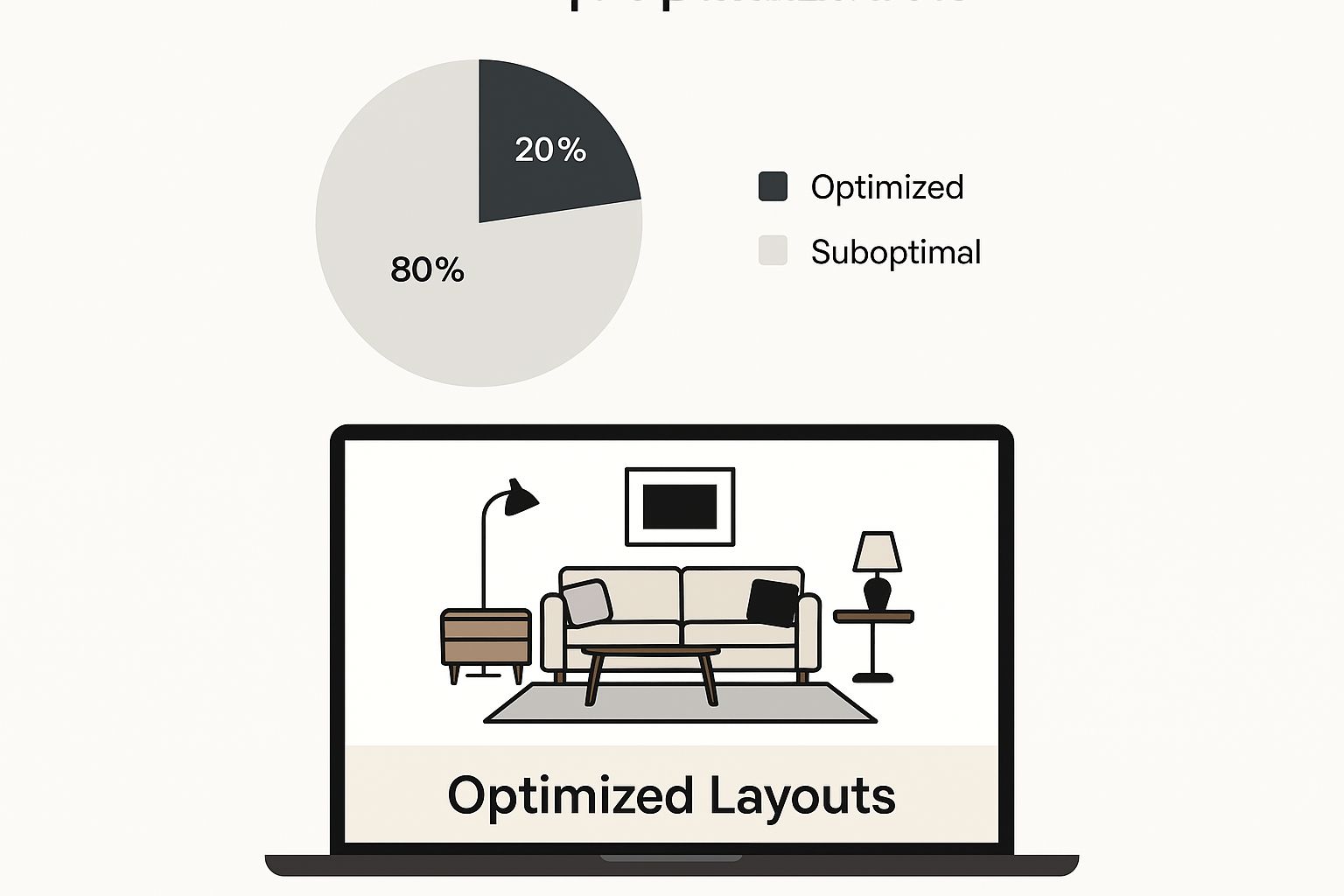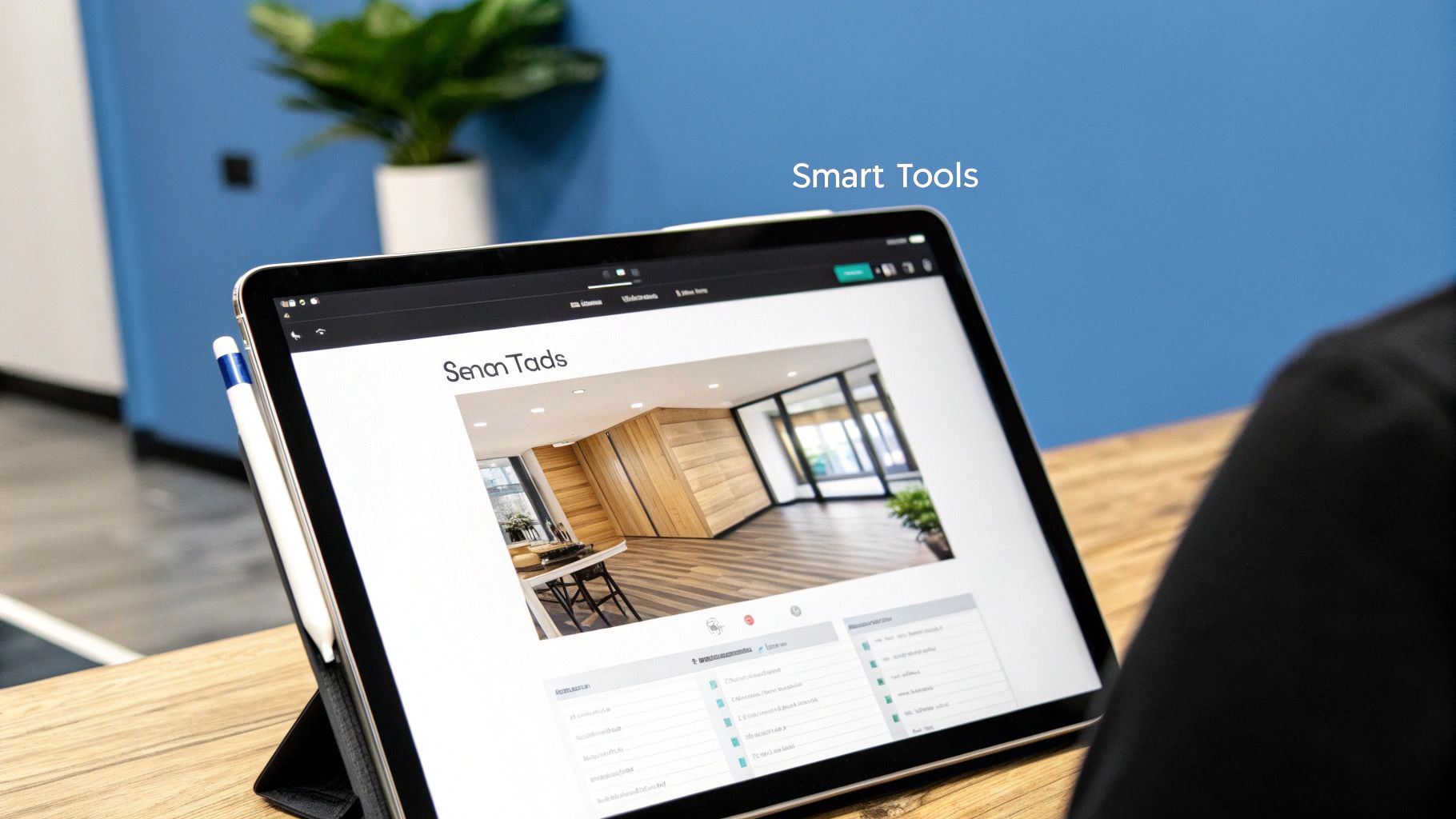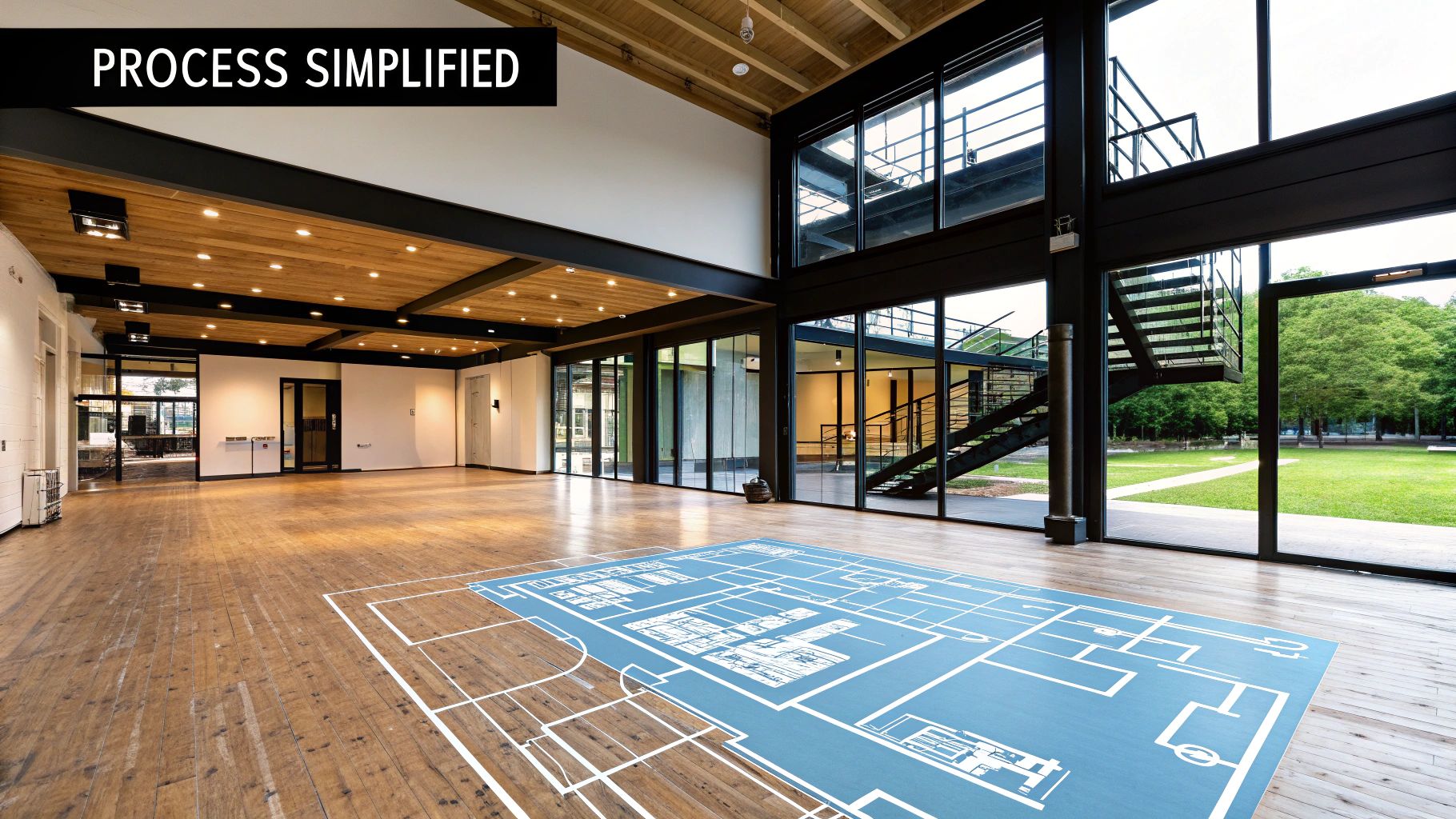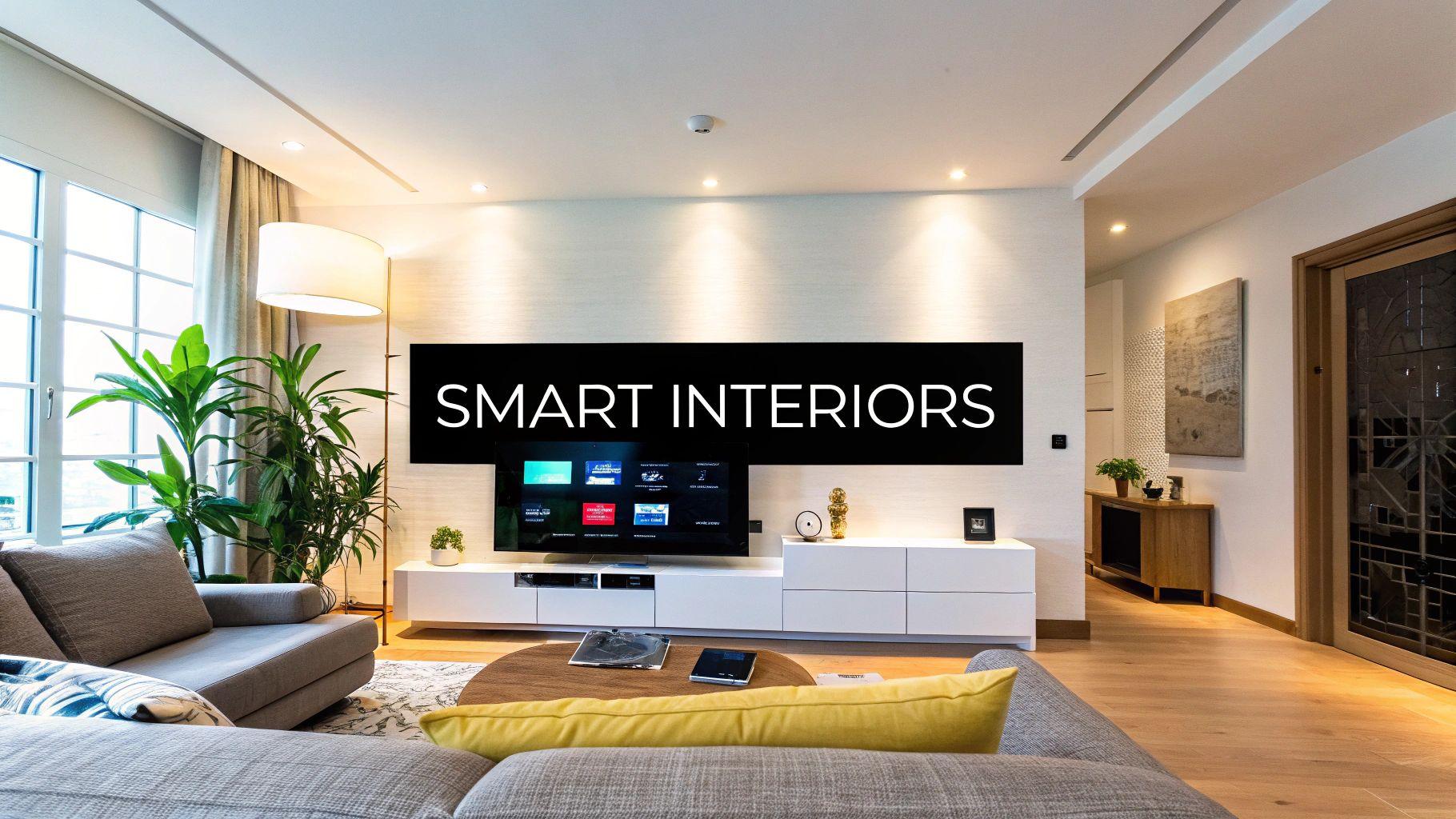Understanding the Smart Design Revolution
AI is reshaping industries, and interior design is no different. This goes beyond simply generating images; AI interior design represents a fundamental change in how we approach our living spaces. It's about making design expertise available to everyone, not just professionals. Imagine easily visualizing your dream home, experimenting with various styles, and planning your space with incredible precision. This is the potential of AI-powered design tools.
How AI Is Changing the Game
AI interior design platforms offer a variety of features, from generating design ideas based on your preferences to creating realistic 3D renderings of your space. These tools can intelligently suggest furniture layouts, color palettes, and even specific décor items, eliminating the guesswork from the design process. For example, imagine uploading a photo of your living room and instantly seeing it transformed in various styles, from minimalist to bohemian. You might be interested in: How to master AI interior design.
Additionally, AI can optimize space planning by analyzing room dimensions and suggesting the most efficient layouts. This allows you to maximize your space, regardless of size, and create a comfortable and efficient living environment. This is particularly helpful for homeowners renovating or simply wanting to refresh their current space.
The Growing Impact of AI in Design
The influence of AI in interior design is not simply a passing trend; it's a rapidly growing market. The global AI interior design market has experienced significant growth, driven by technological advancements and an increasing demand for unique design approaches. The market was valued at roughly USD 700 million in 2023 and is projected to reach USD 4242.8 million by 2033, with a compound annual growth rate (CAGR) of 20.3%. Find more detailed statistics here: AI Interior Design Market Growth. This growth reflects the increasing affordability and accessibility of AI-powered design tools.
This rapid expansion makes professional-quality design more accessible than ever, empowering both homeowners and professionals. It also encourages innovation and competition, resulting in better tools and reduced costs. This evolving environment allows for greater personalization and control over the design process, placing the power of creativity directly into the hands of individuals.
Core Applications Transforming Your Design Process
AI interior design is rapidly changing how we design and experience our living spaces. This goes beyond simply generating visually appealing images. It's about utilizing intelligent tools to craft functional, aesthetically pleasing, and personalized environments. Three key applications are at the forefront of this shift: intelligent space planning, AI-powered furniture selection, and immersive visualization.
Intelligent Space Planning
This application eliminates the guesswork from creating optimal layouts. Instead of physically rearranging furniture or relying on simple 2D planners, AI algorithms analyze room dimensions, lifestyle needs, and even the patterns of natural light. These algorithms then suggest the most effective furniture arrangements. It's like having a virtual design consultant who understands how you actually live in your space. This technology can even maximize the potential of small rooms, resulting in efficient and comfortable living areas.

The infographic above illustrates how AI can optimize furniture layouts for a sleek, modern living room. The optimized arrangement isn't just aesthetically pleasing; it considers practical factors such as traffic flow and functional zones within the room. This detailed analysis ensures that the resulting space is both beautiful and practical.
AI-Powered Furniture Selection
AI-powered furniture selection goes beyond basic color matching. The technology considers your existing décor, style preferences, and budget to suggest furniture and décor that align with your overall vision. This intelligent selection process can save you countless hours browsing online catalogs or visiting furniture stores. It streamlines the often overwhelming process of furnishing a home. This also ensures that the selected pieces work well together and contribute to a cohesive design. In 2023, the solutions segment represented approximately 65% of the AI interior design market, highlighting its importance in the field. You can learn more about the growing market in this report: AI Interior Design Market.
Immersive Visualization
We’ve moved beyond static 2D plans and basic 3D models. Immersive visualization, powered by AI, lets you “walk through” your future space in a realistic virtual environment. This allows you to experience your design choices before making any purchases or beginning renovations. This powerful tool helps you identify potential design flaws, experiment with different color palettes, and make informed decisions with confidence. You can see how natural light interacts with your chosen colors, how the furniture will feel within the space, and how the overall design will impact your daily life.
To understand the various AI interior design tools available, let's look at the following comparison table:
AI Interior Design Applications Comparison
Comprehensive comparison of major AI applications in interior design, showing features, benefits, and best use cases
| Application Type | Primary Function | Key Benefits | Best For |
|---|---|---|---|
| AI-Powered Furniture Selection Tools | Recommends furniture and décor based on existing décor, style preferences, and budget | Saves time on furniture shopping, ensures cohesive design, discovers new products | Homeowners seeking personalized furniture recommendations, interior designers looking for inspiration |
| Immersive Visualization Platforms | Creates virtual walkthroughs of designed spaces | Allows users to experience designs before implementation, facilitates design revisions, enhances communication with clients | Interior designers presenting proposals, homeowners visualizing renovations |
This table highlights the different applications of AI in interior design. Each application type serves a distinct purpose and offers unique benefits to both homeowners and professional designers. Choosing the right tool depends on your specific needs and goals.
Market Growth That Actually Matters to You

The growing popularity of AI interior design signifies a major shift in the design industry. This growth offers real benefits for your next project, whether you're a homeowner or a design professional. Increased accessibility, technological advancements, and market expansion are all contributing to this positive trend.
Increased Accessibility and Affordability
Traditional interior design services can be expensive. AI tools are making design more accessible and affordable, empowering homeowners to manage their projects, explore different styles, and achieve professional results without the high cost. This is especially attractive for budget-conscious homeowners and DIY enthusiasts.
Enhanced Technology Capabilities
Investment in AI technology is driving innovation in user experience. As a result, AI design tools are becoming more intuitive and powerful. Features like realistic 3D renderings, automated furniture placement, and personalized style recommendations are becoming increasingly sophisticated. These advancements streamline the design process, making it more enjoyable for everyone.
Booming Market and Increased Competition
Market growth has a positive impact. As more companies enter the AI interior design market, competition increases. This competition fosters innovation, leading to better tools and often lower prices for consumers. This vibrant market provides users with a wider selection of tools to meet their needs and budgets. The global interior design market is predicted to reach USD 142.41 billion in 2025, up from USD 137.93 billion in 2024. The AI segment is projected to grow from USD 1.09 billion in 2024 to USD 1.39 billion in 2025, at a CAGR of 27.3%. For more information, see AI in Interior Design Market Statistics.
The Future of AI Interior Design
The current trajectory of AI interior design suggests a future of readily available, professional-grade design tools for all. Emerging market segments are addressing niche needs, such as tools for small businesses designing commercial spaces and virtual staging tools for real estate agents. As AI technology continues to advance, we can expect even more personalized and powerful tools that will further reshape the design experience, offering increased creativity, efficiency, and accessibility for both homeowners and professionals.
How Professionals Are Winning With AI Integration

The increasing use of AI in interior design presents a significant opportunity for design professionals. Rather than a threat, it offers a way to enhance their skills and improve their services. Savvy designers are already using AI tools to work more efficiently and collaborate more effectively with clients. This isn't about replacing human creativity; it's about amplifying it. For a deeper dive into available tools, see our guide on the best AI for interior design.
Streamlining Workflows With AI
AI tools can handle tedious and time-consuming tasks. These include generating initial design concepts, creating 3D visualizations, and even sourcing furniture and materials. This allows designers to dedicate more time to the creative and client-focused aspects of their work.
This shift empowers designers to refine concepts and ensure client satisfaction. Ultimately, AI integration allows for a more streamlined and efficient workflow.
Enhancing Client Collaboration
AI-powered platforms can significantly improve client communication. Interactive 3D models, for instance, allow clients to visualize the final design early in the process.
This immersive experience helps clients understand the design more thoroughly, leading to better feedback and fewer revisions. It also encourages greater client involvement and ownership throughout the design journey.
Delivering Faster and Better Results
By automating repetitive tasks and enhancing communication, AI tools enable designers to complete projects more quickly and efficiently. This increased efficiency means designers can take on more projects without compromising quality.
Furthermore, AI adoption is already widespread. Nearly 47% of the interior design industry utilizes AI for tasks such as virtual reality modeling. Looking ahead, approximately 40% of interior design professionals believe AI will be capable of replicating human creativity by 2030. This anticipated growth highlights a significant shift toward AI integration within the industry. Learn more from this report: AI in Interior Design Market.
Balancing Automation With Human Expertise
The successful integration of AI in interior design relies on finding the right balance between automation and human expertise. While AI excels at generating initial ideas and handling technical tasks, the human touch remains vital.
Designers bring essential skills to the table, such as understanding client needs, interpreting design trends, and adding the nuanced details that make a space truly unique. The synergy between human creativity and artificial intelligence is what produces truly exceptional designs. For further insights, read: Our blog post on AI and design creativity.
Designers who embrace AI are not merely adopting new tools; they're evolving their practices to stay ahead in a dynamic market. They're strategically positioning themselves as innovators and leaders in their field.
Career Opportunities in the AI Design Era
The integration of AI into interior design is changing the field dramatically. It's not just impacting how spaces are designed, but also transforming the careers involved. Rather than replacing designers, AI is creating new opportunities and evolving existing roles. This means embracing AI can actually accelerate your career, not hinder it.
Emerging Roles in AI Interior Design
New and exciting career paths are emerging that blend traditional design knowledge with AI proficiency. These roles reflect the industry's changing needs and offer promising prospects for designers ready to adapt and enhance their skill sets.
- Virtual Design Consultants: These professionals use AI tools to provide remote design services, making design expertise more accessible to a wider client base.
- AI Tool Specialists: These individuals possess an in-depth understanding of various AI design platforms and help clients optimize the use of these powerful tools.
- AI-Driven Design Strategists: These experts develop and execute design strategies incorporating AI insights and technologies, ensuring projects are both innovative and efficient.
- Computational Designers: These individuals combine design expertise with coding skills to develop new AI tools and algorithms specifically for interior design applications.
Upskilling for the Future of Design
To stay competitive in this evolving design landscape, developing certain competencies is crucial. Designers should focus on strengthening their skills in the following areas:
- AI Software Proficiency: Mastering popular AI design platforms is becoming indispensable for most design-related roles.
- Data Analysis and Interpretation: Understanding how to analyze data generated by AI tools provides valuable insights for informed design decisions.
- Digital Visualization Skills: Creating compelling visuals using AI-generated outputs will be a highly sought-after skill in the future.
- Client Communication and Collaboration: Effectively communicating design concepts and collaborating with clients using AI tools is key to successful projects.
These skills will enable designers to fully utilize AI's capabilities and position themselves as leaders in the industry. The adoption of AI in interior design is projected to increase job opportunities by approximately 22% by 2030, indicating a positive impact on employment within the sector. Learn more about this trend: AI's Impact on Interior Design Jobs.
Leveraging AI as a Career Advantage
Designers who successfully navigate this shift will be those who embrace AI as a powerful tool for innovation. By integrating AI into their workflows, designers can:
- Increase Efficiency: Automating repetitive tasks frees up valuable time for more creative and strategic work.
- Expand Service Offerings: AI empowers designers to offer innovative services like virtual consultations and AI-driven design strategies.
- Enhance Client Experiences: AI facilitates improved communication and collaboration with clients, leading to increased satisfaction and better project outcomes.
In conclusion, the integration of AI in interior design presents a significant opportunity for career growth. By adapting to the evolving landscape and acquiring the necessary skills, design professionals can not only survive but thrive in the exciting new era of AI-powered design.
Your Practical AI Design Implementation Guide
AI interior design tools offer incredible potential for reimagining your living spaces. This practical guide will help you navigate the process of selecting and using these tools effectively, whether you're a seasoned designer or embarking on your first design project. From choosing the right platform to preparing your space for AI analysis, we'll cover the essential steps for successful AI design implementation.
Choosing the Right AI Design Tool
The first step is selecting the appropriate AI platform. With numerous options available, consider these key factors:
- Your Design Needs: Are you focused on space planning, furniture selection, or complete room transformations? Different tools specialize in different areas. For instance, Planner 5D is known for its robust space planning capabilities.
- Budget: Some platforms offer free versions with limited features, while others use subscription models. Explore various pricing structures to find one that suits your budget. For more information on free options, check out our blog post on free AI interior design apps.
- Technical Skill Level: Some tools are more intuitive than others. If you're a beginner, choose a user-friendly platform with a simple interface.
- Desired Output: Do you need 2D floor plans, realistic 3D renderings, or immersive virtual walkthroughs? Think about what type of output best aligns with your needs.
To help you choose the right tool, we've compiled a comparison table of popular AI interior design platforms:
AI Interior Design Tools Comparison
Detailed comparison of popular AI interior design platforms, showing features, pricing, and user experience levels
| Tool Name | Key Features | Pricing Model | Best For | User Level |
|---|---|---|---|---|
| RoomGPT | Generates room designs based on text prompts or uploaded images | Paid subscription | Quick design concepts, inspiration | Beginner |
| Interior AI | Creates mood boards and style ideas based on images | Paid subscription | Style exploration, professional designers | Intermediate to Advanced |
| CollovGPT | Offers design consultation and generates personalized mood boards | Paid per project | Personalized design advice, complex projects | Intermediate to Advanced |
This table highlights some key differences in features, pricing, and target user levels to help inform your decision. Consider your specific needs and budget when making your choice.
Preparing Your Space for AI Analysis
For optimal results, proper preparation is essential before using AI design tools:
- Declutter and Organize: A tidy and organized space allows the AI to accurately assess the room's dimensions and characteristics, resulting in more precise design suggestions.
- Take High-Quality Photos: Well-lit, clear photos are crucial for AI analysis, particularly for tools that rely on image uploads. Natural lighting provides the most accurate color representation.
- Measure Your Space: Accurate measurements help the AI generate realistic and practical designs. Even if a tool doesn't explicitly require measurements, having them available is useful for verifying design proposals.
Working Effectively With AI-Generated Suggestions
AI design tools offer valuable suggestions, but it's important to use them as a starting point:
- Experiment With Different Styles: Don't hesitate to explore various design styles suggested by the AI. This can inspire new ideas and lead to unique design choices.
- Combine AI Insights With Your Vision: Remember, AI tools offer suggestions; you retain creative control. Integrate the AI's insights with your personal preferences and needs to create a personalized space.
- Refine and Adapt: AI-generated designs often benefit from refinement. Adjust furniture placement, colors, and décor to truly personalize the space.
By following these steps, you can effectively use AI interior design to transform your living space. Remember, these tools are meant to enhance your creativity, not replace it. The goal is to combine the efficiency of AI with your individual vision to create a space you love.
What's Coming Next in AI Design Innovation
The field of AI interior design is constantly evolving. New advancements promise to further change how we design, interact with, and experience our living spaces. From enhanced virtual reality to personalized design recommendations, the future of AI design is full of exciting possibilities.
The Future of Immersive Experiences
Imagine stepping into a virtual replica of your future living room. You're not just viewing a static 3D model, but experiencing the space as if it were already built. This is the potential of advanced augmented reality (AR) and virtual reality (VR) integration in AI design. These technologies are evolving rapidly. Future iterations promise photorealistic visuals and truly immersive experiences.
This means being able to feel the textures of the furniture and see how light interacts with different materials. You can even hear the sounds of your future home, all within a virtual space. This level of immersion is transformative for both homeowners and professionals, enabling greater confidence in design decisions.
The Rise of Hyper-Personalization
AI is becoming increasingly adept at understanding individual preferences and needs. This allows AI-powered platforms like Midjourney to create truly personalized design recommendations. Future AI tools may analyze your lifestyle, hobbies, and even your social media activity to curate designs that truly reflect your unique style.
This level of personalization goes beyond simply choosing a "modern" or "traditional" style. It creates spaces uniquely suited to individual needs. Think AI suggesting specific artwork based on your interests or customizing lighting schemes to match your daily routines.
Sustainability Takes Center Stage
As environmental awareness grows, sustainability is becoming a key consideration in design. AI tools are incorporating sustainability metrics into design recommendations. They suggest eco-friendly materials, energy-efficient appliances, and designs that maximize natural light.
Future developments in this area may include AI-powered analyses of a building's environmental footprint, allowing for more informed design choices. This means that AI design can play an active role in creating healthier and more sustainable living environments.
Smart Home Integration and Responsive Environments
AI design is moving beyond aesthetics and functionality. It's integrating seamlessly with smart home technology to create responsive living environments. Future homes may feature AI-powered lighting systems that adjust based on your mood and temperature controls that optimize energy efficiency based on your schedule. They might even include furniture that adapts to your needs throughout the day. This convergence of AI design and smart home technology allows for dynamic spaces that truly respond to the needs of their inhabitants.
Staying Ahead of the Curve
The rapid pace of AI design innovation requires a proactive approach. To stay at the forefront of this exciting field, consider the following:
- Continuous Learning: Stay updated on the latest advancements and emerging trends by following industry blogs and attending design conferences.
- Experimentation: Don't hesitate to experiment with different AI design tools and platforms. Practical experience provides valuable insights.
- Networking: Connect with other designers and technology experts to share knowledge and discuss the future of AI design.
The future of AI interior design is bright, with constant innovation shaping the way we live and interact with our homes. By embracing these advancements and staying proactive, you can use the power of AI to create truly exceptional spaces.
Ready to experience the future of interior design? InstantInterior AI empowers you to transform any room into a professionally designed space in minutes. Upload a photo, describe your style, and let our AI generate stunning, photorealistic renders. Start your free design today and discover the power of AI-driven design: Transform Your Space with InstantInterior AI
